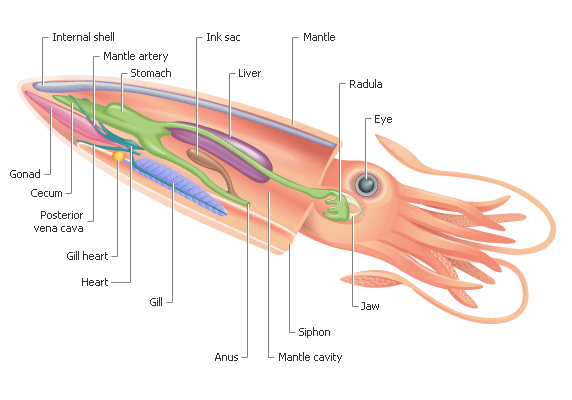Picture this: a creature with mesmerizing eyes, a body that changes color in the blink of an eye, and an uncanny ability to vanish into thin air. It’s a scene straight out of a sci-fi movie, but this incredible being is very real and lives right here on Earth. We’re talking about cephalopods, specifically, the captivating cuttlefish and the enigmatic squid. While they might both be classified as cephalopods, these marine marvels have fascinating differences that set them apart and make them truly unique.

Image:
From their mesmerizing camouflage abilities to their complex intelligence, cuttlefish and squid have captivated scientists and the public alike. Understanding their differences provides a deeper appreciation for the richness and complexity of the marine world and highlights the fascinating diversity of life on our planet. This article delves into the captivating worlds of cuttlefish and squid, exploring their distinct characteristics, lifestyles, and the intriguing reasons why they are often mistaken for one another.
The Cuttlefish: Master of Disguise
The cuttlefish, with its mesmerizing ability to blend seamlessly into its surroundings, is often called the “chameleon of the sea.” This remarkable feat is achieved through specialized pigment sacs called “chromatophores.” These sacs contain different colored pigments that can be rapidly expanded and contracted, causing the cuttlefish’s skin to change color in an instant. This isn’t just about blending in; the cuttlefish utilizes this ability for communication and even to create “flashing” distractions to confuse predators.
Anatomy and Appearance
Cuttlefish possess a unique internal shell, known as a cuttlebone, which helps regulate buoyancy and allows them to rise and sink in the water column. Their bodies are typically broader and more rounded than those of squid, resembling a flattened disk. Furthermore, their eyes are placed on the sides of their heads, allowing for a wider field of vision.
Lifestyle and Behavior
These solitary creatures are primarily benthic, meaning they live on the seabed. They are active predators, mainly hunting small fish, crustaceans, and mollusks. Interestingly, cuttlefish possess a remarkable ability to learn and remember, which is evident in their complex hunting strategies and communication patterns. They are known to use their camouflage skills not only for defense but also to lure unsuspecting prey closer.

Image:
The Squid: Agile and Stealthy
The squid, with its sleek, torpedo-shaped body and powerful tentacles, embodies a vision of speed and grace in the underwater world. While sharing the ability to change color with the cuttlefish, squid have developed a unique combination of features that make them masters of swiftness and cunning in the depths.
Anatomy and Appearance
Unlike the cuttlefish, squid lack the internal shell, relying on their hydrodynamic body structure and powerful muscles for maneuvering through the water. Their eyes are generally larger than those of cuttlefish, providing superior vision in dimly lit environments.
Lifestyle and Behavior
Squid are primarily pelagic, meaning they inhabit the open ocean waters. They exhibit a variety of hunting techniques, from ambushing prey with lightning speed to using bioluminescent lures to attract victims. Unlike the solitary nature of cuttlefish, squid can be found in schools, demonstrating a level of social interaction. Their intelligence is demonstrably high, with some species known to use tools and engage in complex communication patterns.
Cuttlefish vs Squid: Key Differences
While both cuttlefish and squid belong to the same cephalopod family, they each possess specific traits that set them apart. Here’s a breakdown of the key differences:
Shell
- Cuttlefish: Have an internal shell called a cuttlebone.
- Squid: Lack an internal shell.
Body Shape
- Cuttlefish: Broad and flattened, resembling a disk.
- Squid: Sleek and torpedo-shaped.
Eyes
- Cuttlefish: Eyes are on the sides of the head.
- Squid: Eyes are generally larger and more forward-facing.
Habitat
- Cuttlefish: Primarily benthic (seabed).
- Squid: Primarily pelagic (open ocean).
Social Behavior
- Cuttlefish: Solitary.
- Squid: Can be found in schools.
Hunting Techniques
- Cuttlefish: Primarily ambush predators, using camouflage to lure prey.
- Squid: Utilize speed, agility, and bioluminescent lures for hunting.
The Fascinating World of Cephalopods
The differences between cuttlefish and squid are just the tip of the iceberg when it comes to the fascinating world of cephalopods. These mysterious creatures have captivated scientists and the public alike with their remarkable intelligence, complex social interactions, and astounding abilities. Their ability to master camouflage, to learn and problem-solve, and to navigate the underwater world with a degree of sophistication makes them a fascinating subject for research and observation.
Conservation and Future Research
The future of these extraordinary marine creatures is intrinsically tied to the health of our oceans. Pollution, overfishing, and habitat destruction threaten their populations, highlighting the need for conservation efforts. Research into cephalopod behavior and its potential applications is ongoing, with scientists exploring their potential in areas such as biomimicry, neural circuitry, and even medical treatment.
Cuttlefish Vs Squid
Conclusion
From the masterful camouflage of the cuttlefish to the lightning-fast agility of the squid, these cephalopods offer a glimpse into the incredible diversity and complexity of life on our planet. Understanding their distinct characteristics and the reasons for their differences deepens our appreciation for the wonders of the marine world. With the future of these creatures at stake, we must continue to learn about them and advocate for their conservation, ensuring that the mesmerizing mysteries of the cuttlefish and squid continue to inspire and amaze generations to come.






